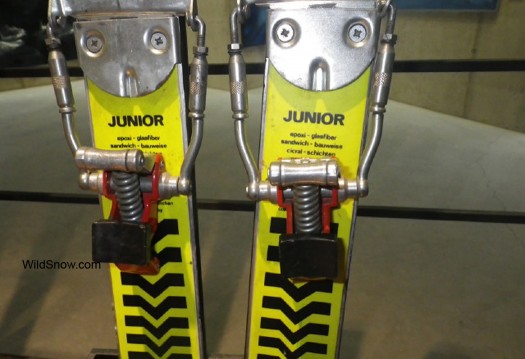1085 grams, 38.7 ounces (1096 grams) per binding, without screws. Circa 1975, takeoff on Iser. Or is Iser a takeoff on the Nepal?
What amazes me about this rig (besides the massive weight), is the detailed effort that obviously went into designing and making a bunch of fairly unique parts and pieces. The binding is nearly all steel (tiny bit of plastic underneath), and has the look of a sort of “craftsman manufacturing,” meaning a lot of hand work. Donator Raymond Contrath said he thought this was at one time the binding of the Alpini (mountain troops) of the Italian army. Poor guys. But quite an interesting addition to the collection.
When you handle the Zermatt Nepal, you realize just how far we’ve come in plastics engineering: being able to make ski bindings out of composites. More, the lack of aluminum is striking. Perhaps the alu supply in Italy was limited in the 1970s, or they found it too hard to work with in this application. Metal still has its place in backcountry skiing bindings, of course, but check out the weight of this nearly all-steel ski binding and you know why plastic is our friend.
See the complete Zermatt Nepal museum display here.
It turns out the Zermatt ski binding has a tragic history. Pioneer extreme skier Heini Holzer had a stunning career in the Alps that spanned a period in the 1960s and 70s, until he was killed in a fall on a trade route in 1977. Over the years, legend held he tripped on a ski pole (which is how we record this event in the WildSnow Chronology). That may not be correct. Donator Raymond Contrath was recently at the Messner museum in Sulden, where they have a pair of skis with Zermatt bindings said to be the planks Holzer was on when he died. Following is info Raymond sent along:
Hello Lou, I have some more information about the Zermatt binding. While in South Tyrol this spring my wife and I visited the Messner Mountain Museum in Sulden. Hardly inside the building I caught sight of this ski touring binding that looked like a Zermatt. I asked the custodian, about the binding and he told me the following:
The bindings and skis belonged to Heini Holzer. He was using them on his fatal descent of the northeast face of Piz Roseg on 4 Jul 77. Eberhöfer said the binding opened on one of the turns causing the fatal fall. Either the lock-down mechanism (from walk to ski) or the heel release malfunctioned. After the accident the company withdrew the binding from the market and overhauled it, the result being the model I sent for the WildSnow collection. Some time in the 80’s Silvretta bought up the binding and it was discontinued. The skis and bindings are being loaned to the museum by Heini’s oldest son, Markus, who is a friend of Eberhöfer. Reinhold Messner, a one time climbing partner of Heini Holzer, is Markus’ godfather.
A comparison of the two bindings (WildSnow collection and those at the museum) shows obvious changes in the heel release mechanism whereas the lock-down system seems to not have been changed. But slight changes in the geometry of this very simple system could effect the reliability of its functioning.

Holzer skis with earlier generation Zermatt binding that is said to have pre released and caused his death.
WildSnow Museum index is here.
WildSnow.com publisher emeritus and founder Lou (Louis Dawson) has a 50+ years career in climbing, backcountry skiing and ski mountaineering. He was the first person in history to ski down all 54 Colorado 14,000-foot peaks, has authored numerous books about about backcountry skiing, and has skied from the summit of Denali in Alaska, North America’s highest mountain.


